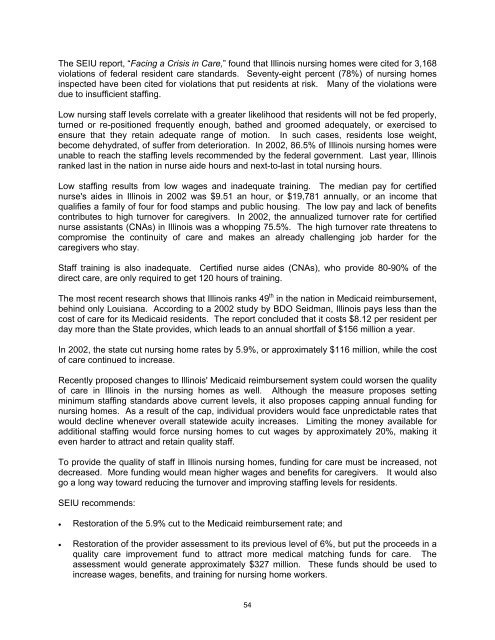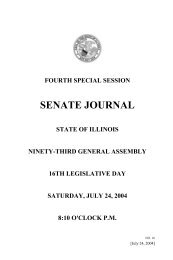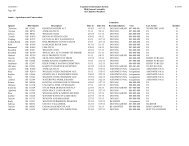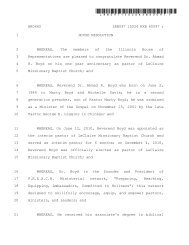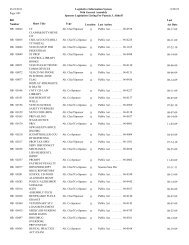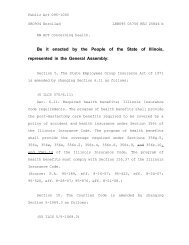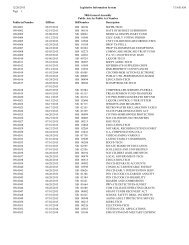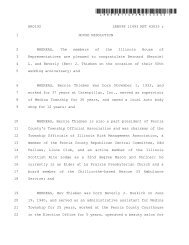Long-Term Care - Illinois General Assembly
Long-Term Care - Illinois General Assembly
Long-Term Care - Illinois General Assembly
You also want an ePaper? Increase the reach of your titles
YUMPU automatically turns print PDFs into web optimized ePapers that Google loves.
The SEIU report, “Facing a Crisis in <strong>Care</strong>,” found that <strong>Illinois</strong> nursing homes were cited for 3,168<br />
violations of federal resident care standards. Seventy-eight percent (78%) of nursing homes<br />
inspected have been cited for violations that put residents at risk. Many of the violations were<br />
due to insufficient staffing.<br />
Low nursing staff levels correlate with a greater likelihood that residents will not be fed properly,<br />
turned or re-positioned frequently enough, bathed and groomed adequately, or exercised to<br />
ensure that they retain adequate range of motion. In such cases, residents lose weight,<br />
become dehydrated, of suffer from deterioration. In 2002, 86.5% of <strong>Illinois</strong> nursing homes were<br />
unable to reach the staffing levels recommended by the federal government. Last year, <strong>Illinois</strong><br />
ranked last in the nation in nurse aide hours and next-to-last in total nursing hours.<br />
Low staffing results from low wages and inadequate training. The median pay for certified<br />
nurse's aides in <strong>Illinois</strong> in 2002 was $9.51 an hour, or $19,781 annually, or an income that<br />
qualifies a family of four for food stamps and public housing. The low pay and lack of benefits<br />
contributes to high turnover for caregivers. In 2002, the annualized turnover rate for certified<br />
nurse assistants (CNAs) in <strong>Illinois</strong> was a whopping 75.5%. The high turnover rate threatens to<br />
compromise the continuity of care and makes an already challenging job harder for the<br />
caregivers who stay.<br />
Staff training is also inadequate. Certified nurse aides (CNAs), who provide 80-90% of the<br />
direct care, are only required to get 120 hours of training.<br />
The most recent research shows that <strong>Illinois</strong> ranks 49 th in the nation in Medicaid reimbursement,<br />
behind only Louisiana. According to a 2002 study by BDO Seidman, <strong>Illinois</strong> pays less than the<br />
cost of care for its Medicaid residents. The report concluded that it costs $8.12 per resident per<br />
day more than the State provides, which leads to an annual shortfall of $156 million a year.<br />
In 2002, the state cut nursing home rates by 5.9%, or approximately $116 million, while the cost<br />
of care continued to increase.<br />
Recently proposed changes to <strong>Illinois</strong>' Medicaid reimbursement system could worsen the quality<br />
of care in <strong>Illinois</strong> in the nursing homes as well. Although the measure proposes setting<br />
minimum staffing standards above current levels, it also proposes capping annual funding for<br />
nursing homes. As a result of the cap, individual providers would face unpredictable rates that<br />
would decline whenever overall statewide acuity increases. Limiting the money available for<br />
additional staffing would force nursing homes to cut wages by approximately 20%, making it<br />
even harder to attract and retain quality staff.<br />
To provide the quality of staff in <strong>Illinois</strong> nursing homes, funding for care must be increased, not<br />
decreased. More funding would mean higher wages and benefits for caregivers. It would also<br />
go a long way toward reducing the turnover and improving staffing levels for residents.<br />
SEIU recommends:<br />
• Restoration of the 5.9% cut to the Medicaid reimbursement rate; and<br />
• Restoration of the provider assessment to its previous level of 6%, but put the proceeds in a<br />
quality care improvement fund to attract more medical matching funds for care. The<br />
assessment would generate approximately $327 million. These funds should be used to<br />
increase wages, benefits, and training for nursing home workers.<br />
54


